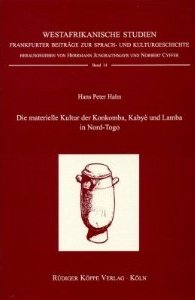
Die materielle Kultur der Konkomba, Kabyè und Lamba in Nord-Togo
Ein regionaler Kulturvergleich
Author: Hans Peter Hahn. Series edited by: Herrmann Jungraithmayr, Norbert Cyffer.
Series: WeStu Westafrikanische Studien Volume 14
199612 pp. Roman, 432 pp.
6 maps, 145 drawings, numerous tables, glossary
Text language(s): German
Format: 160 x 240 mm
700 g
Paperback
€ 69.80
Buy 'Die materielle Kultur der Konkomba, Kabyè und Lamba in Nord-Togo' as a downloadable PDF document directly from our online shop »
Order 'Die materielle Kultur der Konkomba, Kabyè und Lamba in Nord-Togo' as print edition »
In the anthropological discussion, the term material culture includes the utensils and tools of a society as well as forms of house building and settlement. The comparative examination of different manufacturing processes and the utilization of material things allows to draw conclusions from the social and religious living together of the respective group.
The present thesis analyses different aspects of material culture, taking into account different scientific sub-disciplines like cultural ecology, semiotics and historio-cultural anthropology. The author compares objects within the areas settlement and house building, pottery, wood carving, basket and mat weaving, smithery, clothing and jewelry and musical instruments, confronting three Westafrican ethnies (Konkomba, Kabyè und Lamba).
In each ethnic group about 300 objects were analysed and documented with numerous illustrations to point out the regional differences of the material culture of these ethnies which are each represented with its language and history, tillage and the general living conditions. A glossary contains the most important terms of the African languages with its German translations.
Under these links you will find further publications on Gur languages and cultures in West Africa:
Accompanying material:
- Les peuples voltaïques (gur)
(ISBN 978-3-89645-114-9 ) - Pferde, Schwerter und Macht
(ISBN 978-3-89645-112-5 ) - Studien zur Kultur der Moba (Nord-Togo)
(ISBN 978-3-89645-205-4 )
Cross-reference:
- Grammaire kabiyè – une analyse systématique
(ISBN 978-3-89645-034-0 ) - Gur Languages and Nominal Classification Diversity
(ISBN 978-3-89645-613-7 ) - La qualification dans les langues africaines / Qualification in African Languages
(ISBN 978-3-89645-253-5 ) - Le Gulmancema
(ISBN 978-3-927620-17-9 ) - Les langues gur (voltaïques)
(ISBN 978-3-89645-111-8 ) - Noun Class Systems in Gur Languages I + II
(ISBN 978-3-89645-619-9 )
Reviews
Im Hauptteil wird die materielle Kultur der Konkomba, Kabyè und Lamba in gesonderten Kapiteln vorgestellt. In jedem Kapitel werden zunächst die betreffende ethnische Gruppe und ihr Lebensraum vorgestellt. Dann folgt die Darstellung der materiellen Kultur in acht Abschnitten, die teils von der Funktion und teils von den Materialkategorien und den Herstellungstechniken ausgehen: Siedlung und Gehöft, Keramik und Töpferei, Gegenstände aus Holz und Kalebassen, Körbe und Matten, Gegenstände aus Eisen, Bekleidung, Musikinstrumente und Feldbau. Dies ist eine einleuchtende Gliederung [...]
Eine ausführliche vergleichende Betrachtung, die auf einer tabellarischen Darstellung basiert, schlüsselt die gewonnenen Daten auf. Dabei wird auf fehlende, importierte und identische Elemente der materiellen Kultur verzichtet. Hahns Aufschlüsselung kann als Vorbild für ähnliche Arbeiten dienen [...]
Diesem Buch kann man nur eine weite Verbreitung wünschen. Die Aufmerksamkeit der Museumsethnologen dürfte ihm sicher sein – und nicht nur als Nachschlagewerk, sondern auch als Anregung für künftige vergleichende Studien, denn Hahn hat ein sehr brauchbares Konzept entwickelt.
Jürgen Zwernemann in Tribus, 46/1997, 205
| « back | Print version | [top] |
 Books
Books Audio
Audio Biographies
Biographies Series
Series Festschrifts
Festschrifts Journals
Journals